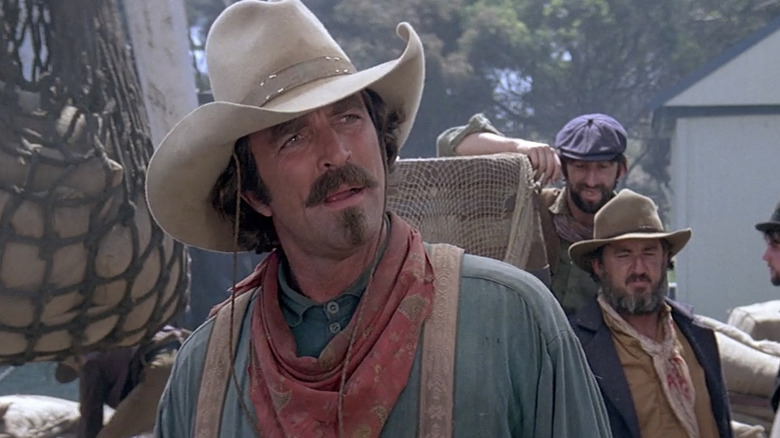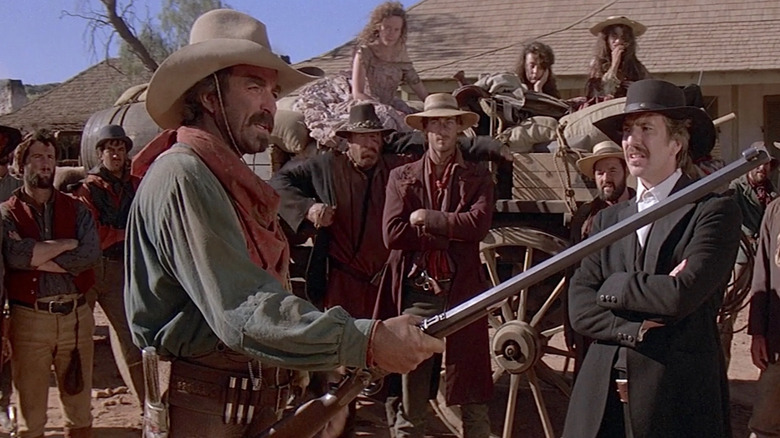Tom Selleck's '90s Western Proves He Should Have Been A Major Movie Star
When Tom Selleck was in college, he spent at least as much time playing basketball and baseball as he did studying acting. Tall and handsome, Selleck was a classic fraternity kid, dazzling people with his athletic prowess and good looks. It wasn't until his senior year in college (he was studying business at USC) that he was told to give acting a shot. Selleck dropped out of school and began studying theater at the Beverly Hills Playhouse. Starting in 1969 and throughout the 1970s, Selleck made a handy career playing small roles and bit parts in dozens of TV shows and movies. He was on shows like "Charlie's Angels," "Mannix," "The FBI," "Taxi," and "The Rockford Files." He turned up in films like "Midway," "Coma," and "Concrete Cowboys." Selleck was always affable and charming, and casting directors loved that about him.
Selleck's big break came in 1980 when he landed the title role in the successful tropical detective series "Magnum, P.I." The series was silly, yes, but it was also eminently watchable, giving Selleck a chance to ply his talents. "Magnum" lasted for 162 episodes over eight seasons, becoming one of the more notable hits of its day. Shortly before it went off the air, Selleck also starred as the co-lead in Leonard Nimoy's 1987 film "Three Men and a Baby," a film that made $240 million on its $15 million budget. It was one of the biggest hits of the year. Selleck, it seemed, was poised to take over both TV and movies.
But his follow-up leading-man projects were never quite as impressive. Case in point: Simon Wincer's 1990 Aussie Western "Quigley Down Under" kind of came and went without much fanfare. In it, Selleck played the titular Quigley, a 19th-century American sharpshooter who is called to Australia.
Quigley Down Under was okay, actually
The premise of "Quigley Down Under" is that Quigley has invented a special kind of rifle that is startlingly accurate at long distances. He takes a job in Australia, working for a rich a-hole named Elliot Marston (Alan Rickman). Quigley didn't know it when he took the job, but Martson had hired him to shoot and kill any Indigenous Australians who wandered onto his property. Quigley immediately and violently refuses, leading to a fracas with Marston and his men. When the dust settles, Quigley and another one of Martson's enemies, Cora (Laura San Giacomo), are tied up and left for dead in the Australian outback.
Quigley and Cora are rescued by the local Indigenous community, and the pair find themselves fighting off Martson's men as they venture into the outback to kill the natives. Quigley becomes a hero against injustice for the locals, secretly aided by gunsmiths and by Cora's wits. Cora, we'll eventually learn, has a tragic backstory of her own. She was originally from Texas, but committed a terrible crime that got her shipped off to Australia. The supporting cast is rounded out by many Aussie actors, including the notable Ben Mendelsohn.
"Quigley Down Under" is entertaining, if slight, and is possessed of appealing righteous indignation. The Indigenous Australians were indeed slaughtered wholesale in the 1800s, and the film's screenwriter, John Hill, wanted to give them some retrospective cinematic justice. The script was written back in 1974, and one can see the grindhouse elements of "Quigley" lurking around the edges. By the time it got made, Westerns were most certainly out of vogue, and Selleck's affable charm robbed the film of any edge. It's okay, but it didn't grab the public's attention.
What critics thought about Quigley Down Under
The film wasn't a hit, making only $21.4 million on an $18 million budget. It may have seemed like a good bet at the time. Not only was Selleck coming off the success of "Three Men and a Baby," but the late 1980s saw a weird surge in Australian media in the United States. This was likely predicated largely by the success of the 1986 film "Crocodile Dundee." By 1990, however, the wave had already broken and rolled back. No one, it seems, wanted an Australian Western with Tom Selleck. It also didn't help that "Quigley Down Under" opened within days of Kevin Costner's "Dances With Wolves." Costner's film wasn't just an awards darling, eventually winning seven Academy Awards (including Best Picture), but it was a massive blockbuster to boot. On a budget of $22 million, "Dances with Wolves" made over $424 million at the box office. "Quigley" kind of got swallowed up in the hype.
Critics weren't too fond of it either. Roger Ebert gave it two-and-a-half stars, feeling the story was clichéd. Gene Siskel gave it two stars, saying that Alan Rickman was the only element that made the film worthwhile. Owen Gleiberman gave the film a D-. Some critics at least liked Basil Poledouris' rousing score.
"Quigley" became widely seen when it made the rounds on cable TV throughout the early 1990s. Indeed, the sharpshooting scenes became famous among gun enthusiasts, and the film inspired a slang term among fans of snipers. To hit an impossible, long-range target is now referred to as enacting a Quigley. One might hear gamers use the phrase. The film is fluff, and its script is only fair, but it's something of a staple.


